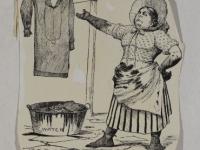For this activity, students will study Dana Barber’s 1884 “Sanitary Survey” as well as William Ludlow's "Address to the County Medical Society" to develop a detailed understanding of the source and kind of pollution that was contaminating the Schuylkill River Valley. In doing so, students will gain an understanding of what defines a watershed, land use, and the challenges of managing upstream/downstream issues related to pollution.
Surveying the Problem of Water Supply in Philadelphia and Debating a Solution
Surveying the Problem of Water Supply in Philadelphia and Debating a Solution
Essential Questions
Objectives
- Students will learn to interpret primary sources.
- Students will assess cause and effect relationships between land use and water pollution.
- Students will gain knowledge of the negative impact of industrialization on the environment.
- Students will present a cohesive interpretation of the past using a visual display of information.
- Students will appreciate the complexities of effective political policy change.
Primary Sources
Other Materials
Suggested Instructional Procedures
- Have students read William Ludlow’s report before class. If so desired, they can also be assigned the accompanying worksheet.
- Print out the 69-page survey if students do not have access to computers and divide students into seven groups for each of the seven districts delineated in the survey. Assemble these groups proportionally based on each district’s population so that some groups will have more students than others. Students should note that, overall, Barber organized the valley by towns “at a pumping station, as most of the towns draw their supply from the river and above their own pollution.”
- Have each group of students study its section of the report and compile all the information into a clear, concise, visual display of information (using applicable “21st-century” computer software programs). These displays should include charts, graphs, and maps depicting at least the following four categories: (1) types of industry, (2) types of pollutants, (3) location of industry related to the river, (4) population figures.
- Have each student group give an oral and visual presentation to the class, starting with the Pottsville District. When finished, display the entire watershed of information, from upstream to downstream, in the classroom.
- After student groups have presented their data, have students self-select a role to play within each of their groups that represents the interests of the town on which they reported. For example, individual students can represent business owners, home owners (or renters), factory workers, mothers with young children, medical practitioners, and inventors, to name a few.
- Have students debate among their groups ways to solve the pollution crisis. Students should incorporate language from William Ludlow’s report to make an effective argument.
- Choose a moderator and make sure that students address as many upstream/downstream issues as possible in their debate about ways to solve the pollution problem.
Vocabulary
Industrialization: the process of introducing manufacturing and the use of new technologies into an economy. In America, industrialization began in the 19th century and was characterized by an increase in factories and methods of transportation.
Pollution: the introduction of harmful substances into the environment
Pumping station: a place where water pumps are installed to provide communal access to a water source
Reservoir: an artificial lake, oftentimes created by a dam, for storing water
Sanitation: the process of providing cleanliness for the purpose of maintaining health
Typhoid: an infectious and often fatal disease caused by unclean food or drink. It is also known as typhoid fever.
Related Resources for Students
Grade Level
Duration
Standards/Eligible Content
About the Author
This lesson was created by Ellen Freedman Schulz. Updated for SAS by Amy Seeberger, Education Intern, Historical Society of Pennsylvania.
Attention Teachers!
Let us know how you used this plan and be featured on our site! Submit your story here.

